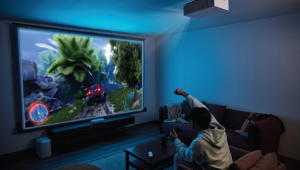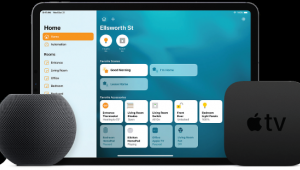Getting Surrounded

Sure, there have been some attempts at upgrading the home audio experience in the form of height channels (Dolby ProLogic IIz and DTS Neo:X) and width channels (Audyssey DSX and DTS Neo:X), but neither of these has any roots in the commercial cinema. And other than a few Blu-ray Discs “optimized” for use with Neo:X, these channels have all been derived via some matrix processing trickery.
However, before the end of this year, home theater audio will see a significant upgrade in the form of Dolby Atmos. (Fortunately, Atmos requires no changes to the Blu-ray or HDMI spec, so if your Blu-ray player is connected via HDMI and can output audio in bitstream, you’re good to go!) Since every receiver manufacturer has adopted virtually every upgrade Dolby has ever introduced—with many already announcing support for Atmos—Atmos will likely make its way into even entry-level products soon, and there’s a good chance your next AV receiver will be Atmos enabled whether you care or not.
So, what is Atmos, and should you care? First, unlike the matrixed height and width channels, Atmos is a commercial audio format. Dolby introduced Atmos in 2012 with Pixar’s Brave, and more than 150 films have been mixed in Atmos so far, with more added constantly, including blockbusters like Iron Man 3, the Hobbit trilogy, Star Trek: Into Darkness, Gravity, and Godzilla. This means tons of major titles are and will be mixed specifically for this next-generation audio format.
Atmos’ other significant difference is it’s based on “audio objects”—up to 128 of them—instead of speaker channels. Brett Crockett, Dolby’s director of sound technology research, describes these objects as, “Any sound heard in a movie scene—a child yelling, a helicopter taking off, a car horn blaring. Filmmakers decide exactly where those sounds should originate and precisely where they move as the scene develops.”
A key part of the Atmos experience is height, or rather, overhead audio information. Because of this, there will be a new naming structure for Atmos systems based on the standard 5.1-channel terminology but adding a number at the end denoting the number of height speakers employed. The recommended Dolby Atmos “reference” home system will be of the 7.1.4 variety, with the seven “listener level” speakers arrayed based on the ITU-R 775-3 guideline for multichannel speaker layouts augmented with four overhead speakers.
Dolby says four overhead speakers delivers more precise positioning of objects as they move front to back and around the room, but other Atmos iterations can be employed such as 5.1.2, 5.1.4, 7.1.2, and more, up to megasystems supporting the maximum 24.1.10 layout. No matter how many speakers—or their layout—the Atmos renderer will utilize them to full effect.
Ideal ceiling heights range from 9 to 12 feet, and if you can install speakers in your ceiling, Dolby claims virtually any high-quality in-ceiling speaker with a wide dispersion quality should be fine. Obviously, selecting models that timbre-match your main channels would be smart. However, when an in-ceiling install isn’t practical or possible, you can use special Dolby Atmos-enabled speakers or modules that will reflect the “height” signal off the ceiling, creating a very similar effect. In fact, during a demo of both speaker types, there were times when I found the floor-mounted Atmos-enabled speakers to be more immersive than the in-ceiling models.
Having heard an Atmos home theater demo at Dolby’s New York offices, I have to say the sound is very encompassing and impressive, creating a dome of audio that surrounds you and makes it far easier to track objects. It also “lifts” sounds up into the room in a very realistic manner, making overhead sounds like rainstorms or helicopters sound like they are truly overhead. Overall, the Atmos system gave the sensation of being wrapped in a cocoon of audio.
As an added bonus, Crockett told me, Dolby feels that, thanks to the way the Atmos renderer handles audio objects in an Atmos surround mix, an Atmos-capable receiver playing an Atmos-enabled movie will sound more enveloping and immersive even without adding any additional speaker channels. Thus, an Atmos receiver will make your existing system sound better. Not too shabby.
- Log in or register to post comments






























































